The Pests and Vermin
We've set out below some brief information on a range of common pests and vermin which PBFS Pest Control Services deals with effectively at a competitive price. The list is only an example as we cover all known pests and vermin in the following areas.
Pest Control Market Rasen, Pest Control Horncastle, Pest Control Lincolnshire, Pest Control Caistor, Pest Control Louth, Pest Control Brigg, Pest Control Gainsborough and all surrounding villages.
 |
Black Ant
|
 |
Wasp(Common - Vespula vulgaris, German - Vespula germanica)The hazard of wasp stings is universal knowledge - very few people manage to avoid being stung at some time or another. Wasps chew through the skin of apples, pears, plums and other fruits in order to reach sweet pulp. When wasps are abundant, such damage can be severe to the commercial grower as well as the private gardener. Wasps chew wood to make pulp for their nests, and where this occurs on, for example, garden furniture, timber cladding on houses, etc it is sometimes seen as a problem. |
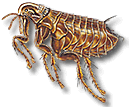 |
Flea(Cat Flea - Ctenocephalides felis)Flea bites are most often found on the lower leg. Fleas as adults are parasites on warm blooded animals, eg humans, cats, dogs, birds, etc. These are known as hosts. Those most commonly found in homes hospitals and offices are cat fleas, but others (dog fleas, bird fleas, hedgehog fleas and occasionally human fleas) may also occur. The historical links with the Bubonic Plague, caused by a bacterium carried by the black rat flea, are widely known. |
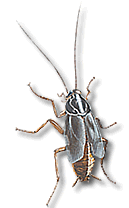 |
Oriental Cockroach(Blatta orientalis)Blatta orientalis is now known as a major pest of buildings, notably in cellars, basements, ducts, boiler rooms, kitchens, bakeries, toilets and bars. It is the major cockroach pest in Britain. Because of its habits and feeding sites, it is a potential carrier of pathogenic bacteria when associated with food. People also find their presence and odour repulsive. A recent study in the USA suggests that nearly one fifth of the population is allergic to cockroaches, their droppings, odour and breakdown products. |
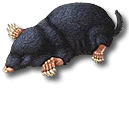 |
Mole(Talpa europaea)Moles are solitary and very territorial, only coming together to breed. The presence of moles is usually noted by the appearance of casts of earth thrown up from tunnels excavated below ground. The quantity or mole hills is not an indication of the number of moles present. Moles are so fiercely territorial that one mole's territory might be as much as 200 m2 (1 imperial acre), and even in the largest of garden situations, many casts of earth will be the result of one mole. Moles rarely traffic above ground and droppings or surface runs never occur. |
 |
House Mouse(Mus domesticus)Reproduction rates of mice are impressive, and in theory nearly 2000 offspring in one year could result from just one pair of adults (1 doe + 1 buck), given ideal conditions. After mating there is a gestation period of 21 days before 5-6 young are born. At birth, baby mice weigh just 1 gramme. They are weaned after only 3 weeks and sexually mature after only 8-12 weeks. Each female can have up to 10 litters in a year. Mice can live up to 2 years in the lab, but usually live less than 12 months in the wild. They are fiercely territorial. |
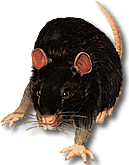 |
Brown Rat(Rattus norvegicus)Many signs of infestation may occur, droppings being the first possible sign followed by gnawing. Damage to fabrics, excavations around or under buildings, well worn runs through undergrowth or smear marks (a dark mark caused by body grease) over surfaces which are crossed regularly are other tell tale signs. Where infestations occur near water courses holes will often be present in the banks as this offers an excellent escape route as rats are accomplished swimmers. Rats have five senses like humans, with particularly well developed hearing, smell and touch, but they are colour blind. They do have good movement detection. |
 |
Cluster Fly(Pollenia rudis)There are three main species of fly collectively known as cluster flies. They are Musca autumalis, a small fly of about the same size and colour as the house fly, Pollenia rudis, a larger fly dull brown/grey in colour, and lastly Dasyhora caynella which is about house fly size and shiny green/blue in colour. Cluster flies can successfully hibernate undetected between these two layers. Often cluster flies can be seen basking on sunny grassland or resting on south facing walls of buildings. Cluster flies, like birds, return to roof spaces previously occupied so re-infestation is almost inevitable. |
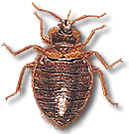 |
Bed Bug(Cimex lectularius)Detection is visual sightings of adults. Blood (Faecal matter) spotting, Complaints of bites around neck and waist. Unlike other species of bugs, the bed bug is wingless. It is thought that the species came form Asia, but they are now cosmopolitan, being found in all four corners of the world. They were well known in ancient times in the Mediterranean area, but as they require a warm and dryish climate, they did not spread further north until the advent of heating in buildings. When this happened, their spread became relentless. |
 |
Rabbit(Oryctolagus cuniculus)Apart from the visual damage caused by grazing, a number of small scrapes may be noticed, where attempts to obtain roots have taken place. These signs, and large amounts of hard round droppings can easily be seen. Often, on well established routes to feeding areas runs are easily visible and they can be followed from the warren to a chosen feeding ground. Damage to trees or shrubs can also be seen in the winter months when food is short and this can be extensive to smooth barked species. Trees can be killed by this stripping of the bark unless a guard or fencing is erected for protection. |
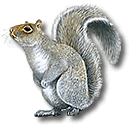 |
Grey Squirrel(Sciurus carolinensis)The squirrel nest is known as a drey, and is made of twigs and leaves, and can sometimes be lined with grass. When dreys are made in roof spaces, the squirrels will gather all manner of fabrics, gnawed cardboard etc. to act as nesting materials. Squirrels have a surprisingly wide and varied diet, eating foods such as fruits, nuts seeds, plant and tree buds, fungi, and new shoots. They will also take birds' eggs and even the nestlings. Obviously, bird food etc. put out in gardens becomes an easy target, but because many people like squirrels, the food is put out specifically for them. |
Whatever pest or vermin is causing you problems, get in touch with Example Pest Control for a competitive and effective solution.
